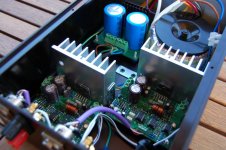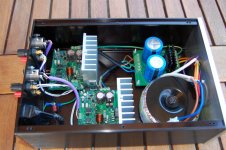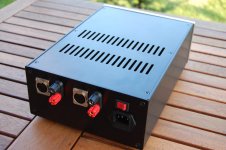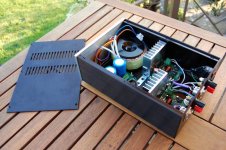But you must play a good record, with high DR (dynamic range). FLAC or similar. Orchestral mass if it is possible, please.
-> Album list - Dynamic Range Database
Something like this:
Dynamic Range Meter - foobar2000
ComponentFree Downloads | DYNAMIC RANGE | pleasurize music!
Dad typically plays Radio 3 on FM. The dynamics on BBC Radio 3 live concert broadcasts are better than the vast majority of real world CDs.
I will also use various CDs such as this:
http://www.amazon.co.uk/D-Shostakovich-Symphony-Uppsala-Chamber-Orchestra/dp/B005OMOFY6
And this:
Walton: Symphony No 1, Cello Concerto / Rattle, Harrell | ArkivMusic
Ultimately what will it mean for other people though?
His speakers have relatively very high sensitivity for the size the room and listening distance. They are also an easy load. Also neither of us like ear bleeding volume so it would actually be really hard to tax the amplifier in his system.
Last edited:
5Hz !=DC. I can't recall the frequency of Tom's servo but likely to be around 0.1Hz
Modulus-86 Rev. 2.0: 65 mHz
Modulus-86 Rev. 1.0: 2 mHz
~Tom
A higher dynamic range does not automatically mean a better recording...
True, DR is not the only thing to consider but it is a great indicator. In commercial music the DR of the reissues are becoming smaller, sounding much worse than the original.
As you can not compare the amplifier with commercial music in MP3 from an average mobile phone...
The current disaster is so great that I had to hide me in excellent vinyl rips 24/96 (from analog master about 90%) to enjoy music that is not classical or jazz.
I know, if things are done well, a CD or SACD offer better sound but the record companies do not reward excellence, with the exception of famous labels of classical and jazz.
By the way, I listen now:
foobar2000 1.3.8 / Dynamic Range Meter 1.1.1
log date: 2015-04-02 23:22:54
--------------------------------------------------------------------------------
Analyzed: Verdi - La Traviata - Scotto, Kraus, Bruson, Muti
--------------------------------------------------------------------------------
DR Peak RMS Duration Track
--------------------------------------------------------------------------------
DR18 -0.44 dB -25.86 dB 31:03 ?-sideA
DR16 -0.69 dB -24.73 dB 32:18 ?-sideB
DR17 -0.31 dB -23.54 dB 31:56 ?-sideC
DR17 -0.25 dB -24.95 dB 33:48 ?-sideD
--------------------------------------------------------------------------------
Number of tracks: 4
Official DR value: DR17
Samplerate: 96000 Hz
Channels: 2
Bits per sample: 24
Bitrate: 2603 kbps
Codec: FLAC
=================================================
I have a number of recent recordings with superb dynamic range. The Dutton label recently had a sale and I got a load of excellent recordings for a few € each. Their reissues are excellent too.
Oh and most mobile phones have pretty good performance now from their DACs. Some have 24bit audio systems.
Currently listening to a new recording of Mahler 9 from the Halle orchestra. Starts off around -40dB .
But most important is that people do critical listening with music they know and like. It's sighted so expectation bias is at play, but an old faithful from the collection will at least give some sort of reference point.
Oh and have fun 🙂
Oh and most mobile phones have pretty good performance now from their DACs. Some have 24bit audio systems.
Currently listening to a new recording of Mahler 9 from the Halle orchestra. Starts off around -40dB .
But most important is that people do critical listening with music they know and like. It's sighted so expectation bias is at play, but an old faithful from the collection will at least give some sort of reference point.
Oh and have fun 🙂
Motors and transformers generally need a fuse that is rated for three times the normal maximum current to avoid nuisance blowing during start up.
A 225VA running on 240Vac has a maximum current of 0.94Aac
Three times this gives 2.8A
A T2.5A or T3.1A will be suitable for direct on line starting.
A close rated fuse would be as stated by Tom, i.e. a fuse rated at ~ 0.94A
For a close rated fuse starting a transformer you will need a soft start.
A 225VA running on 240Vac has a maximum current of 0.94Aac
Three times this gives 2.8A
A T2.5A or T3.1A will be suitable for direct on line starting.
A close rated fuse would be as stated by Tom, i.e. a fuse rated at ~ 0.94A
For a close rated fuse starting a transformer you will need a soft start.
Motors and transformers generally need a fuse that is rated for three times the normal maximum current to avoid nuisance blowing during start up.
A 225VA running on 240Vac has a maximum current of 0.94Aac
Three times this gives 2.8A
A T2.5A or T3.1A will be suitable for direct on line starting.
A close rated fuse would be as stated by Tom, i.e. a fuse rated at ~ 0.94A
For a close rated fuse starting a transformer you will need a soft start.
Cheers,
Looks like I should've just gone straight to 2.5A. I will see how the 1.6A and 2A cope first.
Headphone amplifier with Modulus-86 (LM3886)?
Tom,
Tom,
Have you ever thought about the possibility of creating a version for headphones with the Modulus-86 (LM3886) working to lower voltage?
Impedance out?
They could with any headphones with the exception of electrostatic.
Many weeks that it did not use the headphones and what a difference!
Impedance out?
They could with any headphones with the exception of electrostatic.
Many weeks that it did not use the headphones and what a difference!
Last edited:
Too much gain = too much avoidable noise.
Headphones need a Buffer (+0dB), or very low gain +6dB, or at most +12dB.
10times gain is +20dB and 28times gain is +29dB
Headphones need a Buffer (+0dB), or very low gain +6dB, or at most +12dB.
10times gain is +20dB and 28times gain is +29dB
Power-86 module with soft start
For smaller transformers, say <=200 VA, a soft start is usually not needed as the transformer has enough internal resistance to limit the current to a reasonable value. Larger transformers, could benefit from a soft start circuit ... or a larger fuse. Either approach is valid...
~Tom
Perhaps you should design a new Power-86 module with soft start to use with Parallel-86.
Modulus 86 (with 225va transformer; 2x18v secondaries) amplifier now working on 230/240v 50hz UK mains.
1.6A fuses are blowing when the amplifier is switched on, every few power ups. With a pack of 10 hopefully they will last until the 2A fuses turn up!
Hopefully I will have the opportunity this week to start to assess the quality of the amplifier, from a subjective standpoint.
1.6A fuses are blowing when the amplifier is switched on, every few power ups. With a pack of 10 hopefully they will last until the 2A fuses turn up!
Hopefully I will have the opportunity this week to start to assess the quality of the amplifier, from a subjective standpoint.
Last edited:
Fit a soft start. Then you can get reliable start ups using a close rated fuse of around 800mA to 1A
Fit a soft start. Then you can get reliable start ups using a close rated fuse of around 800mA to 1A
Hi Andrew,
Thanks, it's a possibility, I know it's a small circuit but it still might be a problem finding some space to comfortably put it in this case though.
From the initial tests playing music at average domestic volumes (I realise not very scientific!) The amplifier runs cool as a cucumber; LM3886s barely manage to get lukewarm and just about take the chill off the heatsinks.
Modulus 86 with 225VA 2x 18V transformer:
Hooked up to the amplifiers (which were connected to speakers but not playing music) the power 86 board output voltages were +/- 26.95V.
Initial tests it sounds clear, crisp, detailed, open and by comparison with tube amplifiers tight in the bass.
Proper listening tests to follow.
Modulus 86 with 225VA 2x 18V transformer:
Hooked up to the amplifiers (which were connected to speakers but not playing music) the power 86 board output voltages were +/- 26.95V.
Initial tests it sounds clear, crisp, detailed, open and by comparison with tube amplifiers tight in the bass.
Proper listening tests to follow.
Attachments
Fit a soft start. Then you can get reliable start ups using a close rated fuse of around 800mA to 1A
That would be a nice touch. With a small transformer like that, I don't see much of an issue, though.
From the initial tests playing music at average domestic volumes (I realise not very scientific!) The amplifier runs cool as a cucumber; LM3886s barely manage to get lukewarm and just about take the chill off the heatsinks.
Nice build, dude! That came together nicely.
~Tom
Perhaps you should design a new Power-86 module with soft start to use with Parallel-86.
Duly noted.
Designing a good soft start is actually a bit of a challenge. The circuit needs to work well with a wide range of transformers. It needs to provide a good soft start (that's sorta the point of a soft start circuit) under normal operation, meaning that it limits the in-rush current to a reasonable value. It needs to do with without exceeding the limits of the components (that's a problem with many resistor-based soft start circuits). It also needs to make sure that the soft start is engaged when the power comes back after a short, say, 10-second outage. I prefer that the circuit is self-contained, i.e. does not connect to the secondary of the power transformer.
There are many soft start circuits out there. Mine needs to be the best of the bunch.
~Tom
When feeling particularly steampunk one night I did consider a 3-way switch with a 'prime' position to charge through a resistor,. My rig, only I turn it on after all !
That would be a nice touch. With a small transformer like that, I don't see much of an issue, though.
Nice build, dude! That came together nicely.
~Tom
Hi dude!,
Thank you for this excellent design, installed today, Dad is very happy with it and spent several hours listening. I'm really glad he likes the sound, especially after such (in its day) expensive solid state and his valve gear.
It is a very tight fit in places in this aluminium case, it took quite some arranging to get the transformer in next to the PSU board; allowing for cable management and positioning the heatsinks in line with the ventilation holes (the latter part obviously overkill when you see how cool running it is).
Driving his sensitive speakers in a small room even at very high volume the heatsinks or LM3886's never went beyond lukewarm, which was a surprise.
Even when I had it to myself for a while playing Mahler's 3rd at high volume, loud crescendos producing no discernible extra heat. I followed this with Kraftwerk's live album Minimum Maximum; a real monster bass mix (especially the live version of Chrono) again no discernible change in temperature.
Whatever we played CD or Radio 3 live concerts it is obviously not an amplifier that adds any discernible character to the sound. You hear the recording, the speaker's own character and room interaction. Of course those are always the most prominent characteristics of any competent, truly Hi-Fi audio system, but the modulus is indeed a design to be considered in the relatively "blameless" class.
Attachments
Last edited:
- Home
- Amplifiers
- Chip Amps
- Modulus-86 build thread



